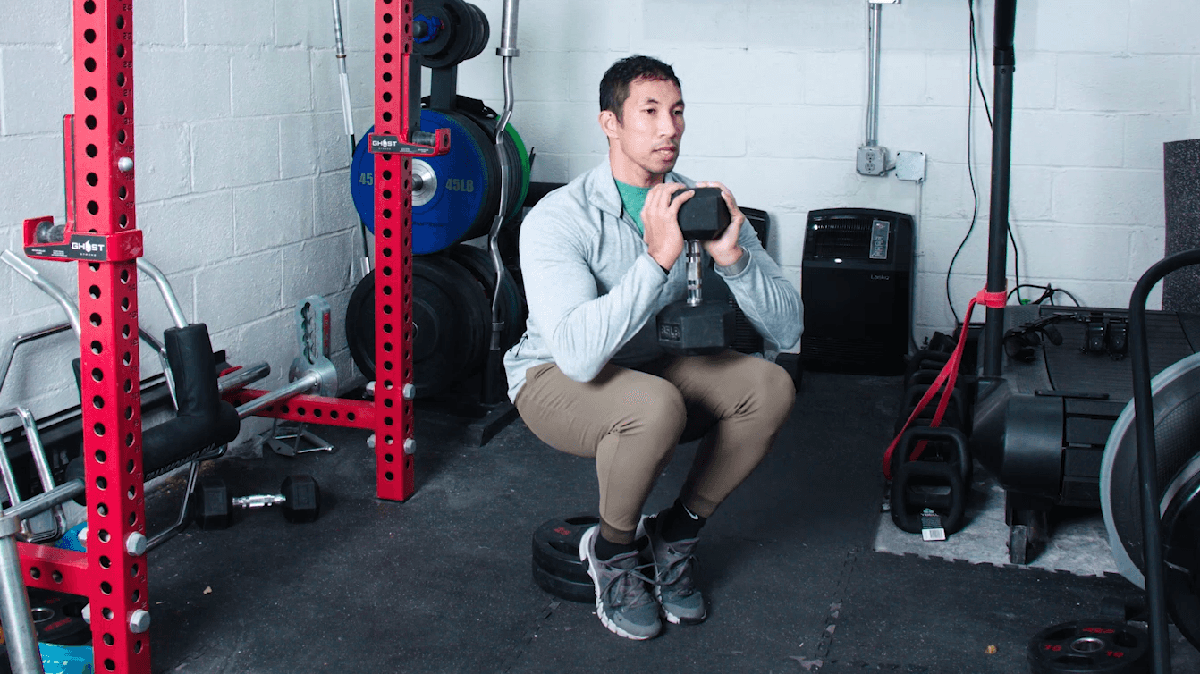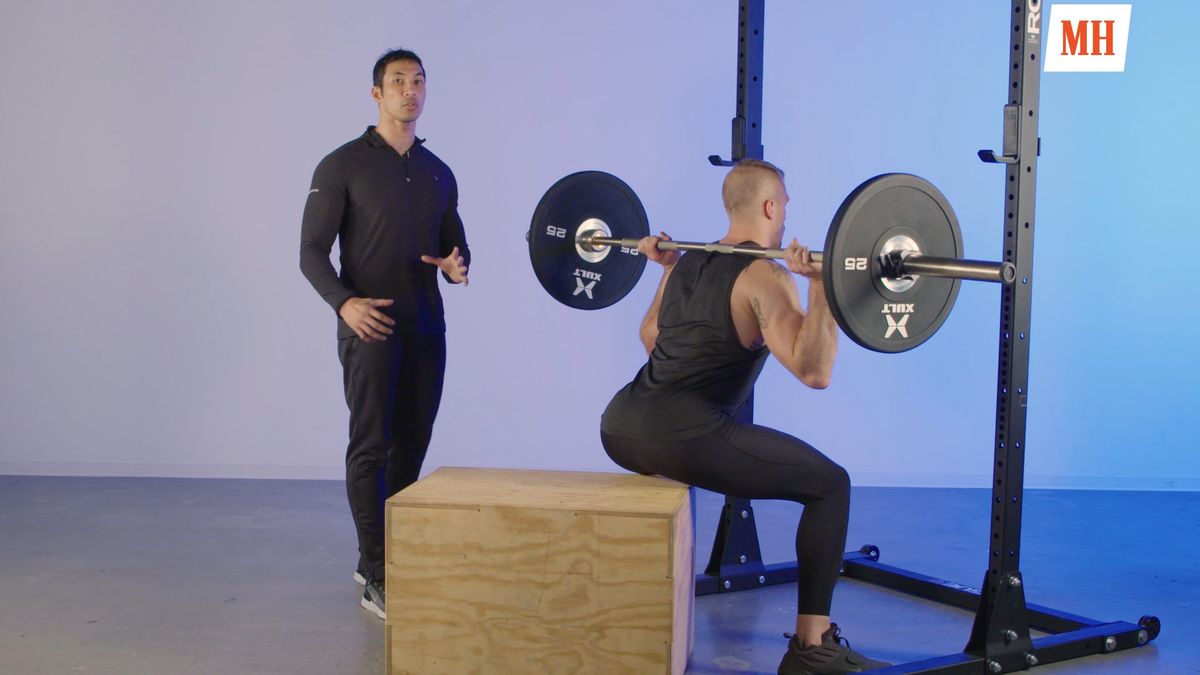How Deep Should I Squat?

HOW LOW SHOULD you go? When it comes to the move often referred to as the king of all exercises, the barbell back squat, that can be a contentious question. Some internet exercise policemen say if you’re not ass-to-grass (in other words, your butt nearly touches the floor), your squat’s a pretender to the throne. But if your goal is to get bigger or stronger, experts say, that’s not the case.
“The history of squatting below parallel was really based on the need to have something to judge in competition… If you think of your big three at a powerlifting meet—bench press, deadlift, squat—the squat is the only one with an unclear stopping point,” says Shawn Arent, Ph.D., C.S.C.S., chair of the Department of Exercise Science at the University of South Carolina. For the bench, it’s to touch your chest with the bar at the bottom, and lock your elbows at the top. For the deadlift, you’ve got to pick the bar up off the floor until you’re standing.
Squats needed a standard, so just below parallel was chosen. But for getting stronger, that depth “isn’t anything inherently necessary for the exercise.”
The right depth depends on your body and mobility, say Arent and Juan Guadarrama, C.S.C.S., a strength coach in Los Angeles. Here’s how low you should go, the dangers of pushing to get your butt down too far, and what to do if you want to get your ass closer to the grass.
How Deep Most Guys Should Squat
“Parallel is good enough for the regular gym-goer, because there’s really no reward for going deeper,” says Guadarrama. “If we are going for strength, going parallel is deep enough for the strength adaptation we’re looking for, and for the central nervous adaptation we’ll get from being under heavy load.”
Parallel, for those uninitiated in the gym, means the top of the thighs are roughly parallel in relation to the floor below you. For illustration of what just below that would look like, USA Powerlifting Rules state: “the lifter must bend the knees and lower the body until the top surface of the legs at the hip joint is lower than the top of the knees.”
For athletes in certain sports, a deeper squat may be necessary. In addition to powerlifters, Guadarrama says, Olympic lifters—who need to be strong in a deep squat position for snatches—will want to squat deep, as will combat sport athletes.
But for other athletes and regular guys, the risks that come with going deep may not be worth the effort. The squat challenges three joints at once: The hip, knee, and ankle. And if one of those joints isn’t mobile enough to get deep, another joint will compensate to get your butt to your calves.
“To get to that low point, for many people, one of two things happen: You can get pretty significant extension or flexion in your low back,” Arent says. “So you need to tuck your hips in order to reach that at the bottom, or you wind up pushing your butt even farther back, so your low back is in extension.”
Being able to get ass to grass, he says, “comes down to how well you are able to maintain spinal alignment when doing that. If you can, there’s nothing inherently wrong with that. If you can’t, you put yourself in a much riskier position for very little additional upside.
What Can Keep You From Deep Squats
Of the three joints involved in the squat, the most common issues arise from the ankle, Guadarrama says. Specifically, it’s the ankle’s ability to dorsiflex—to move the toes up towards the shin.

Dorsiflexion can be improved in an acute way, he says, by warming up fully, or by activating the ankle tissue with a foam roll or lacrosse ball. (Try some of these ankle-strengthening exercises if you feel like your dorsi won’t flex.) If your ankles just won’t flex, you can also get deeper by raising your heels on a slant board or on a weight plate.
For other guys, the thing holding them back from deep squats may not even be in the lower body, Arent says.
“If you’ve got shoulder problems or just inflexibility in the shoulders, the ability to get the chest, shoulders, and back aligned and in a position where they can adequately handle the bar may be a limiting factor,” he says. Men experiencing this issue may be able to get lower by replacing back squats with front squats. “This can make it easier to go deep without feeling like you’re pitching forward.”
Squatting Above Parallel Can Still Make You Stronger
If you can’t get to parallel, that’s okay, too. If your mobility in one of the three joints involved in the squat—or in your upper body—keeps you from being able to reach that 90-degree mark, you can still get stronger, Arent says. Squatting to almost parallel will still challenge your ability to control the weight and challenge your quads and hamstrings.
“What you don’t want is those three- to five-inch range of motion things where people have way too much weight loaded on the bar, and they’re basically doing minor knee bends,” he says. If you find that’s as much as you can handle, lighten the load on your back until you can go deeper.
How You Can Improve Your Squat Depth
While an ultra-deep squat isn’t essential for building strength, developing that range of motion is good for athleticism and real-world movement, Guadarrama says—even if you aren’t doing it under load.
“The reason for this is being able to express the full function of the hip, knees, and ankles,” he says, so when you need that range of motion, you’ve got it.
You can also use accessory exercises other than heavy barbell squatting to hone your depth. Goblet squats, for instance, are a valuable tool for beginners to improve their form.
Whether you want to get low in an air squat, or bring your barbell squat down to parallel, these three moves will help you go deeper.
Heel-Elevated Squat

Raising your heels makes the squat require less ankle dorsiflexion, so it’s easier to practice getting low.
If you think this is “cheating,” Arent says, “think about how weightlifting shoes, or ‘squat shoes,’ are designed: They’ve got a non-compressible elevated heel, with the idea that it puts you in a more advantageous mechanical position.”
If your gym has a slant board, you can start with that, Guadarrama says, then work your way down: As your ability improves, squat with your heels on 25-pound plates, then 10-pound plates, then fives, and so on, continuing to use thinner and thinner plates as your ankles get more mobile.
Tibialis Raise
These have become very popular in recent years for increasing dorsiflexion, Guadarrama says, and with good reason: They’re just a move where you’re practicing dorsiflexion, and strengthening the muscle—the tibialis anterior, on the front of your shin—that lifts your toes towards your knees.
Add these into your warmup a few times per week.
- Stand with your back against a wall, your feet about hip-width apart. Walk your feet away from the wall slightly to create an angle between your body and the wall.
- Keeping your heels on the ground, lift your toes towards your knees. Feel the flex in your anterior tibialis, the muscles on the front of your lower legs.
- Hold for a beat, then slowly lower to the floor. Repeat.
Box Squat

Squatting down to a box that’s just below the level you can reach with a barbell squat can help you practice getting into lower and lower positions, Guadarrama says.
“What you’re looking for is to have control of the weight to the lowest possible position,” he says. When you get there, sit down for a beat, but don’t let your spine go slack. “Pause there for a split second without losing tension in the body, and then press back up.”
Start with a weight that is around a seven out of 10, effort-wise, and aim for four sets of five repetitions. As you feel more comfortable, lower the box or bench you’re using a little, and continue progressing over time.




